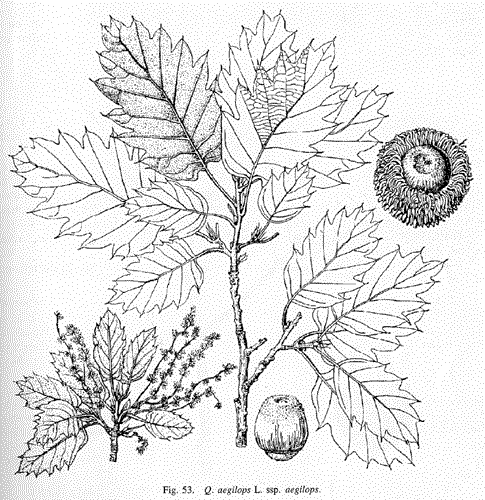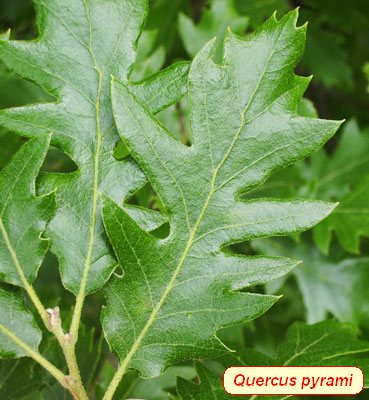| Quercus ithaburensis | |
| Author | Decaisne 1835 Ann. Sci. Nat., Bot. II, 4: 348 |
| Synonyms | aegilops subsp ithaburensis
(Decne)Eig 1933 aegilops var. ithaburensis (Decne) Boissier 1879 macrolepis subsp ithaburensis (Decne) Browicz 1978 |
| Local names | Mount Thabor's oak; |
| Range | Southeastern Italy; South Albania; Greece; Turkey; Asia Minor. Syria; Lebanon; Palestina; Israel; |
| Growth habit | to
15 m tall; trunk and branches often gnarled; crown round; |
| Leaves | 4-9
x 2-5 cm; oval or oval-lanceolate; leathery; marcescent; often with margin
wavy or revolute, with 7-10 pairs of shallow lobes (or teeth); apex
obtuse, base rounded; dark green, hairless (or someones), convex above;
grey, tomentose beneath; petiole hairy1-2 cm long; |
| Flowers | |
| Fruits | acorn
to 5 cm long x 3 cm wide, oval or narrowly ellipsoid; cup with broad,
thick, stiff, free, appressed or recurving scales; maturing in 2
years; |
|
Bark, twigs and |
young twig hairy; bud ovoid hairy; |
| Hardiness zone, habitat | hardy
but suffers from deep cold; all types of soils; slow-growing; |
| Miscellaneous | --
A. Camus : 115; -- Sub-genus Cerris, Section Cerris, subsection Aegilops (with macrolepis and brantii); -- The term "aegilops" is very confused, as it has been given to several species: _aegilops L. or Auctores (Boiss. or Lam.) = Q.ithaburensis subsp macrolepis _aegilops Griseb. = Q.trojana _aegilops Scop. = Q.cerris _aegilops Mill. = Q.pubescens so it is better to give up with it ! |
| Subspecies and varieties |
2 subspecies: ---subsp ithaburensis:
A.Camus n° 115 ---subsp macrolepis
(Kotschy) Hedge & Yaltirik 1982 |
| Pictures |
|









